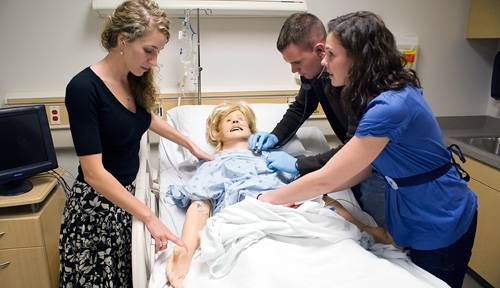EDITOR’S NOTE: The redesign of the College of Medicine curriculum is moving full speed ahead with implementation slated for the beginning of the 2017-2018 school year. To help people become more familiar with the process and gain a better understanding of what the college hopes to accomplish, InterCOM plans to carry a series of articles over the next several months on curriculum reform.
The series continues this month with a rundown of the three phases of UNMC’s curriculum redesign. In subsequent articles, we will explore:
- What curriculum redesign will mean to current students and future students.
- The faculty involved in curriculum redesign.
- What curriculum redesign will mean to COM faculty.
Part III
Three phases of curriculum redesign
To accomplish curriculum redesign, a three-phase approach to the curriculum was taken.
In Phase 1, the primary student learning experiences were organized by organ system and basic sciences, clinical sciences and certain health systems sciences were incorporated in an integrated fashion. Phase 2, which was similar to our current M3-year, was moved earlier in the four-year curriculum. Phase 3, which has been significantly restructured around student-selected career tracks, better prepares students for residency training in their chosen field.
"Under our old curriculum, we taught students disparate things on various organ systems over the course of a calendar year or more," said Kelly Caverzagie, M.D., associate dean for educational strategy for the College of Medicine and the leader of the COM curriculum redesign effort. "Learning can be more difficult when you spread things out over this long period of time.
"With curriculum redesign, we tried to bring together these disparate learning experiences and integrate them into organ systems-based blocks, such as the Circulatory Block, which brings together anatomy and embryological development of the heart, physiology, function of the heart, disease states and treatments of the heart."
Phase 1, known as the Foundations of Medicine Phase, extends over the course of 18 months and spans the majority of the first two years of medical school. One unique feature of the Foundations Phase is the introductory Foundations Block provides all students with a common starting point, or foundation, as they begin medical school. Students also will learn critical skills, such as professionalism and effective study habits, to help them succeed in medical school.
Phase 2, known as the Clinical Applications Phase, will consist of clinical rotations in six core disciplines and will occur over the course of one calendar year. While the structure of this phase will be the same as our current curriculum, the timing will change so that it will start in March as opposed to July.
Phase 3, known as the Career Preparation Phase, will extend over 13 months and will provide individualized training for each student with the intent of fully preparing the students for success in their choice of residency training.
To accomplish this goal, students will follow a guided path in the specialty of their choosing by choosing a Specialty Track. These tracks, through the use of required rotations that have enhanced responsibilities and expectations, preferred electives and a mandatory capstone experience, will fully prepare our students to excel in residency training.
"Through the restructuring of the timing of all three phases," Dr. Caverzagie said, "it is important to note that students will have the opportunity for three extra rotations prior to the beginning of the last year of medical school. This will allow them to explore various specialties or careers prior to applying for residency."
